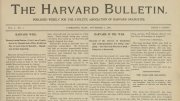MAGA at Harvard
In “Gen Z’s Right Turn” (September-October, page 20), Harvard Republican Club president Leo Koerner ascribes his conversion to a conservative viewpoint to resentment over early attempts to contain COVID-19 through mask mandates, lockdowns, and school closures, despite a lack of certainty over their effectiveness. It is worth recalling the devastating toll that the disease took and the supposition, later validated, that transmission might be respiratory. A teenager’s frustration is an understandable source of resentment but hardly a productive basis for the political organization of society.
Stephen Poppel ’65, Ph.D. ’73
Ghent, N.Y.
Re: “Gen Z’s Right Turn,” the adults among us need to take a lesson.Is talking to one another so terrible?
Nancy Dyar, M.A.T. ’67
Oakland, Cali.
To talk about MAGA in terms of “liberal” and “conservative” is misleading. MAGA is about authoritarianism versus democracy. I doubt many Harvard students support authoritarianism. See the entry on Wikipedia on antidemocracy philosopher Curtis Yarvin, who has supporters such as Peter Thiel and J.D. Vance, and pay particular attention to Vance’s quote about not abiding by Supreme Court decisions. Then please provide an article about that.
Thomas N. Locke ’74
Golden, Colo.
I am disappointed that the article’s online title, “How MAGA Went Mainstream at Harvard,” resorted to hyperbole. The article says a 12 percent minority of students in the Class of 2023 identify as conservative (not even necessarily pro-“MAGA”) and cites an Institute of Politics event that only drew a “small” crowd of red hats. This certainly represents a growing cohort and an important evolution within the campus dynamic, but hardly a mainstream ideology. The underlying story is more than interesting enough that it doesn’t require such embellishment.
Jacob Trenholm, M.P.H. ’24
Ancaster, Ontario, Canada
Your recent letters and essays about Harvard’s supposed “existential fight” against MAGA, and your hand-wringing over Gen Z’s political drift, were self-congratulatory nonsense. You are not in any existential struggle—stop patting yourselves on the back.
When I attended Harvard nearly 50 years ago, the school leaned left. Today it has crossed into full-blown indoctrination—anti-science, anti-common sense, and hostile to dissent. Conservative students are routinely silenced or penalized, and too many faculty mistake ideology for inquiry. That is not education; it is reeducation.
If you wish to be an ideological seminary, that is your choice. But if you accept billions in taxpayer dollars, you are obliged to uphold the values of a republic: fairness, tolerance, and judging people by character rather than identity. Otherwise, Harvard forfeits its claim to public trust and public money.
Don Andrews, M.T.S. ’82
Agoura Hills, Cali.
Thank you for the article describing how Trump et al. are reshaping campus politics (“Gen Z’s Right Turn,” September-October, page 20). It reminded me of a movement on the part of a small group of us in 1955-56 to do the same thing that resulted in the publication during that school year of a 20-issue newspaper called The Harvard Times-Republican that was distributed free of charge to every room in the Harvard/Radcliffe complex.
The fact that we were doing this at Harvard, not then or now known as a Republican stronghold, received a lot of attention. The Harvard Crimson wrote a scathing editorial, which criticized some of our activities that resulted in the cancellation of J. Robert Oppenheimer’s planned speaking visit to the College.
We learned a lot about life and politics while stirring up some interesting and sometimes worthwhile controversy on campus. As I approach my 90th birthday in November 2025, I am proud to have participated in that long-ago endeavor to increase Republican visibility at Harvard.
Eugene Yeates ’57
Lebanon, N.H.
Harvard agrees to diversify its political points of views within the classroom and among faculty? Bravo, as long as academic integrity is maintained. I can’t wait until this standard is applied to Brigham Young University, Notre Dame, and Liberty University. Until then, “equal protection” of the laws offer a safe harbor, and we should lay anchor.
Greg Blonder, Ph.D. ’82
Brookline, Mass.
I find it laughable that Harvard,pressured by the Trump administration, envisages a center for conservative scholarship. Scholarship worthy of its name mediates the old and the new, the “conservative” and the “progressive.” We scholars, personal politics irrespective, revel in inconvenient truths, regardless of their origin. So doing increases our chances of finding Truth.
With this in mind, Harvard and its Gen Z 2.0s should ponder two questions:
(1) How have the Library of Congress, the Smithsonian Institution, the NIH, and similar researchhubs improved by becoming centers for conservativescholarship?
(2) Would you vote forapresident who has extorted a major university in order to chastise its collective political character?
Ira Braus, Ph.D. ’88
Pembroke, Mass.
The Faces of Harvard’s Student Body
I was struck by the drawing on the cover of the magazine showing three Harvard students. Three students to represent all of Harvard. Yes, a difficult task, and perhaps one the magazine should have avoided based on a review of the artwork. Indeed, the cover seems to depict only white students. The drawing is also misaligned with current gender demographics as it presents two males and one female student when Harvard has more women than men undergraduates.
Am I being overly critical? Was the drawing merely intended to be illustrative of students generally? Or, alternatively, a backdrop to best present the shifting political leanings of students? Or was it possibly even predictive (aspirational for some) regarding Harvard’s future enrollment? The drawing is problematic because it poorly conveys the composition of Harvard today. Rather, it feels more reflective of a distant past, like Harvard/Radcliffe of the 1950s—a period which seems to be popular for some these days.
Philippe Benoit, J.D. ’84
Washington, D.C.
I’ve been watching Harvard design plans against antisemitism. But what is it doing about anti-Blackism? Both Harvard’s awareness and ignorance of that situation is evidenced by the September-October cover that shows a MAGA student flanked by surprised white students. Is it too much to ask for Harvard to promise to handle anti-diversity matters on campus in a holistic way, or is the Harvard community supposed to accept that the experience of one group matters more than the experience of others? POC alums can tell you: MAGA was always at Harvard. The only thing new is the hat.
Janet Savage, J.D. ’85
Los Angeles
Two Years of Doxxing
Your article on doxxing is flawed.The AAUP, which you cite as a credible organization, has supported boycotts of Israeli academics.Also, the assault of the student on the Harvard Business School campus should not be called “alleged.” It happened, and the video of the assault is public and uncontested.
Students have the free speech right to protest.Others have the free speech right to disclose the identities of the protesters.Bravo for Canary Mission for saving us all the time to research those whose views are antisemitic.
Robert Huebscher, M.B.A. ’82
Lexington, Mass.
I do not pity the Harvard students who faced backlash for signing the October 8 statement blaming Israel for Hamas’s genocidal rampage.“Free speech” does not mean speech is costless. The October 8 statement, which condoned terrorism, rape, and murder, was a sickening display of intellectual poverty and moral rot. One cannot expect to take such a position and escape criticism or accountability.
Some tactics used to shame these students were corrosive. That does not excuse hateful or bankrupt views. As Max J. Krupnick shows, there is a long history of exposing those who want to have their cake and eat it too.
This isn’t about academic freedom. Within the classroom, students should be encouraged to take intellectual risks, test ideas, and explore alternative viewpoints. In the real world, hateful speech can come with a high price.
Michael Snow, J.D. ’23
Brooklyn, N.Y.
The author compares the revealing of the identities of these students to the McCarthy Red Scare. But condoning murder of innocent civilians in an unprovoked terror attack is not equivalent of supporting communism. One condones a crime, the other a form of government.
It is because of articles like this that Harvard is deservedly losing its reputation as one of the world’s great universities.
Alisa Rubin Peled. Ph.D. ’94
Israel
I was so hopeful that this article would be a comfort and a balanced look at the shocking reaction to the events of October 7. The pro-Palestinians’ rapid, virulent, and hateful response to the murder, rape, and kidnapping of Israeli civilians the day after it happened allowed barely a second for grieving, for those who cared. The pro-Hamas camp was clearly prepared for such an event to happen.They went after Jewish American students, not Israel. They used the influence they purchased from Harvard and went to town intimidating and harassing students and creating an environment that encouraged Jew hatred. Your article glosses over all this and is despicable.
Linda Blade, A.L.M. ’09
Warren, R.I.
Your article re: doxxing is beyond disturbing. You humanize the man responsible for the doxxing campaign without clearly articulating the dangers your students have faced as a result of the doxxing. You seem to compare the doxxing of students opposing occupation and apartheid to the doxxing of members of the KKK, an interesting choice.You discuss the doxxing campaign without pointing out the power imbalance among the various actors: billionaires vs. students. You fail to explore the point of the doxxing, which is to silence debate and opposition to the war in Gaza.
What professors have been disciplined or fired and what programs have been cancelled as a result of this doxxing campaign? Those are pretty important aspects of this story, which you have left out.
Megan Ault, M.T.S. ’11
Springfield, Ill.
International Students
Regarding “Why Harvard Needs International Students” (September-October, page 32): the need and benefit are not distributed evenly across all disciplines. The exposure to variety makes sense in international relations and political science, and it may have some utility in education. In STEM, on the other hand, the goal should be to attract the best and brightest students and instructors, domestic or international.
When international students’ full tuition is paid by their governments, that can be both a blessing (money) and a curse (the baleful influence that accompanies an addiction to the money and the allocation of spaces away from deserving U.S. students).
Conversely, when considerable U.S. government assistance directly or indirectly supports universities, it is fair for our taxpayers and government to exercise oversight on whether expenditures to educate noncitizens are beneficial, insofar as exporting American values in an effective way, or wasteful in the sense of providing net value to inveterate adversaries and opponents.
Robert Kantowitz, J.D. ’79
Lawrence, N.Y.
Thank you for your continuing challenge to think about the margins! I was especially impressed with the opinion piece by Mr. Reimers, “Why Harvard Needs International Students.”
As a 2000 graduate of the Kennedy School looking back, international students’ attendance helped me realize that America is not, by the Creator’s design, right about everything.
Tim Mathern, M.P.A. ’00
Senator, North Dakota State Senate
Fargo, N.D.
The Winthrop House Name
I was both surprised and delighted to learn that the Harvard committee tasked with recommending whether to change the name of Winthrop House has recommended against the student-initiated “de-naming” request.
The students who recommended the name change pointed out that John Winthrop—the eighteenth-century Harvard professor after whom Winthrop House is named— was a defender of slavery. However, back then quite a few prominent citizens defended the system of Black subjugation. It is healthy that modern society be reminded of our sometimes sinful and sordid past. As the Spanish philosopher George Santayana has so aptly put it: “Those who have forgotten the past are doomed to repeat it.”
Harvey A. Silverglate, LL.B. ’67
Cambridge, Mass.
Public Health and Medicine
The recent article on the changes at the Chan School of Public Health stated, “Because corporations aren’t driven by an interest in basic science, but instead by avenues of research that could lead to commercially viable products, a substantial challenge of the shift toward corporate-sponsored research will be developing new, objective means of assessing the quality and importance of faculty research” (“A Reckoning, and a Chance to Reinvent,” September-October, page 15).
What a pity and how shortsighted.We won’t be seeing the likes of a Bell Lab again?And basic research in the medical and health fields is undoubtedly going to lead to some financial rewards.
Perhaps the school can encourage continued basic science research by extracting a tax on corporate grants of, say, 20 percent to be applied to a basic research fund. Any profits that arise should be plowed back into research and graduate student training, but if the marketplace realities are just too great, some of the profits could be distributed back to the corporations on a prorated basis.
Lawrence Berman, M.D. ’63
Wyckoff, N.J.
The magazine’s upbeat description of Chan School of Public Health Dean Andrea Baccarelli’s decision, in the face of existential federal funding cuts, to “pivot” to corporate partnerships and “easy, quick, and cheap” solutions overlooks the school’s longstanding commitment to domestic U.S. health policy engagement and, most importantly, advocacy. Will the Chan School lead resistance to this administration’s dangerous plans to defund and deconstruct the U.S. public health system? Will any public health faculty who remain after these cuts be protected if they challenge Secretary Robert F. Kennedy Jr.’s anti-vaccine, anti-scientific lies? We ignore these questions at our peril.
Lauren Waits, S.M. ’94
Atlanta, Ga.
A letter proposes expulsions
The letter from Mark Rutzick, J.D. ’73, in the September-October issue (page 6) is mind-boggling.
“Harvard can adopt whatever restrictions on free speech it feels are necessary to enhance students’ educational experience.” Restricting speech enhances education? That’s beyond oxymoronic; leave out the “oxy” part.
Harvard should ban phrases “threatening, directly orindirectly(emphasis mine), thelife (ditto) of any Jew anywhere in the world?” Bit of a stretch. If I were to point at a fellow Harvardstudent in a hostile crowd and shout “Kill that Jew!” the law would be down on me instantly and the University would kick me out in a heartbeat. It’s neither constitutionally protected speech nor tolerable student behavior. But not everybody who embraces the “river-to-the-sea” slogan advocates murdering Jews. And at a university, if nowhere else, the way to counter bad speech is with better speech.
A “100 percent expulsion rule forspeech violations(my emphasis again)—with no exceptions?” Draconian. Worse: Trumpian.
Robert Hecker ’69
Guilford, Vt.
In response to Mr. Rutzick’s letter: Of course, Harvard is not bound by the First Amendment protection of free speech. But its entire existence as an educational and research institution indisputably binds it to protect freedom of speech. Without it, a university is a mere weathervane. The idea of banning people from chanting “from the river to the sea, Palestine will be free” is frightening, particularly when it is remembered that the Likud Party’s founding document stated, “Between the Sea and the Jordan there will only be Israeli sovereignty.”
Richard E. Brodsky, J.D. ’71
Coral Gables, Fla.
Name, Image, and Likeness
In the new era of university sports revenue-sharing and Name, Image, and Likeness arrangements, recruiting a championship team, especially in big revenue sports like football and basketball, is increasingly a function of the wealth of a university and its alumni. With their long histories of educating the nation’s captains of finance and industry, this seems like the ideal moment for the Ivies to opt into NCAA Division I.
Harvard is being hounded and abused for most everything else they do, so this may be the moment to embrace big time sports and give our image a boost.Ten thousand rich alumni, one victory today!
John Walsh, M.P.P. ’78
Catonsville, Md.
Can Women Have It All?
The title of Yasmeen Khan’s essay, “Baby, Maybe?” reminded me of the book, “A Baby? …Maybe” (Bobbs-Merrill 1975), authored by my late wife, Dr. Elizabeth Whelan (S.M. ’68, S.D. ’71), during what Ms. Khan describes as second-wave feminism, when educated women achieved equal opportunity in the workplace and began to ponder whether they could balance motherhood and careers. Elizabeth and I did “have it all,” raising our daughter, Dr. Christine Whelan, to be an Ivy League and Oxford graduate and a mother of five, as well as an author and a professor of sociology. I encourage Ms. Khan to “want it all”—and to read Elizabeth’s book for some guidance.
Stephen T. Whelan, J.D. ’71
New York, N.Y.
Crimson Finery
The College Pump (“Tips of the Hats,” July-August) was in error when it said that only those who earn the Ph.D. degree get to “strut the crimson finery.” Back in 1992, when I received my Ed.D. from the Harvard Graduate School of Education, I and my fellow Ed.D. recipients definitely wore crimson gowns AND velvet tams. We were not an aberration. As someone who was the director of career services at the education school from 1983-1991 and who attended many Harvard graduations, I can report that the crimson gowns were regularly donned by Ed.D. recipients. (HGSE did not confer PhDs in that era.)
Belle Brett, Ed.D. ’92
Wells, Maine
Primus VI responds: Thanks to Belle Brett for correcting my error (and congratulations on your Ed.D. and the accompanying crimson finery). Stephan Magro, the University’s Commencement director, clarifies: recipients of Ed.D. and other Ph.D.-equivalent degrees, such as the Business School’s D.B.A., have since 1955 worn crimson doctoral gowns. Current equivalent degrees, like the Law School’s S.J.D., also qualify. Degrees not considered Ph.D.-equivalent, like the Graduate School of Education’s Ed.L.D., do not entitle their recipients to the crimson gown. Primus appreciates the opportunity to get the record right.
Errata
In “The Professor Who Quantified Democracy” (July-August, page 33), Kilmar Abrego Garcia should have been identified as Salvadoran, not Venezuelan. We regret the error.








